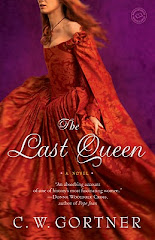 of the forthcoming novel BY FIRE, BY WATER. Set in 15th century Spain during the reign of Isabella and Ferdinand, this beautifully written tale is about the ordinary men and women swept up in the chaos and upheaval of the Inquisition and the 1492 Expulsion of the Jews. Publisher's Weekly has praised the novel as "a naturally cinematic narrative" and Patricia Sullivan for The Historical Novels Review calls it "an engrossing read... [with] real men and women rather than historical caricatures."
of the forthcoming novel BY FIRE, BY WATER. Set in 15th century Spain during the reign of Isabella and Ferdinand, this beautifully written tale is about the ordinary men and women swept up in the chaos and upheaval of the Inquisition and the 1492 Expulsion of the Jews. Publisher's Weekly has praised the novel as "a naturally cinematic narrative" and Patricia Sullivan for The Historical Novels Review calls it "an engrossing read... [with] real men and women rather than historical caricatures."This can be very difficult subject matter for a novelist, both because of its complex historical context as for its tendency to incite a modern-day viewpoint of events that happened over 500 years ago. Mr Kaplan, however, has created a vividly rendered and sensitive account of this intense time as seen through the eyes of Aragon's converso chancellor, Luis de Santangel, who helped convince Queen Isabella to finance Columbus, and Judith Midgal, aunt of Columbus's official translator. His portrayal of this remarkable man and woman and their struggles to reconcile their past with their future amidst a rising storm of persecution humanizes his tale; and his evocation of a troubled Spain at the crossroads of its own past and future is equally well drawn.
Please join me in welcoming Mr Kaplan, who has offered us this post about the circumstances leading up to his decision to write By Fire, By Water.
My Circumstances at the Time by Mitchell James Kaplan
I was living in Paris, in the chambre de bonne (maid’s room) of Monsieur M, a French political figure, and his wife, an attorney. I had very little money, so in lieu of rent I conversed over breakfast with Monsieur and Madame’s three children. My job was simply to keep their English fluent. A maid, a cook, and a chauffeur attended to their other needs. After breakfast, I lay on my bed and immersed myself in the literary worlds of Balzac, Baudelaire, Proust, Julien Gracq, Albert Cohen, and other French writers. I yearned to become a novelist, myself. I wanted to write a book that would grab readers and not let them go, a book that would say something important about the human condition. The problem was, I had no subject. So I kept reading. Reading was a form of prayer.
Sometimes, in the afternoon, I crossed the Pont Royal to the Bibliotheque Nationale. Housed in the seventeenth-century palace of Cardinal Richelieu, of Three Musketeers lore, the French National Library allowed visitors to circulate in its outer salons, where a manuscript by Gustave Flaubert sat in a long glass case. I marveled at the great author’s perfectly balanced, sweeping penmanship, the handwriting of an extreme perfectionist.
Visitors like me were not allowed to enter the main reading room. I peered inside, thinking: That’s where the real writers hang out. I asked a librarian how I might obtain a card. “Je suis désolé, Monsieur.” He shook his head and shuffled away solemnly, as if saddened to encounter yet another lost soul in the labyrinth of literary dreams. In the Centre Américain, Madame Boyd, a middle-aged volunteer who made it her job to look after American students, gave me a business card. “This man is a movie producer. He wants English lessons. I know you’ll hit it off.”
The movie producer, D, took his English lessons over dinner, offering plenty of wine with the boeuf bourgignon or coq au vin. My liver, utterly untrained in these matters, had no idea what to do with so much alcohol. I stumbled home through the small streets of Paris, wondering where life was leading me.
It didn’t take long for D to learn that I was an aspiring writer. He introduced me to a book editor who worked for the publisher Robert Laffont. Two days later, I received a letter on the publisher’s stationery, addressed to the management of the Bibliothèque Nationale. Armed with this letter, I once again presented myself to the librarian, who placed a card in his typewriter and asked for proof of my identity. I’ll never forget the pride I felt. Only “real” writers and editors had the right to this little rectangle of cardboard. From then on, I spent my afternoons reading there instead of in my little chambre de bonne.
It was in the Bibliothèque Nationale that I came across a curious little book that contained a list of the sailors who accompanied Christopher Columbus on his voyage of discovery in 1492. Most were men and boys from southern Spain; others hailed from Galicia, the Basque country, Portugal, Venice, Genoa, and Calabria. All possessed skills deemed necessary for a long voyage aboard a fifteenth-century sailing vessel – except one. Luis de Torres was Columbus’s “interpreter.” He spoke Hebrew, Aramaic, Arabic, and Spanish. I wondered: Why did Columbus need a translator who spoke Hebrew, Aramaic, and Arabic? Where, exactly, did Columbus think he was going? What did “the Indias” really mean, to Columbus?
The question stayed with me. It nagged me. I began reading books about Spain at the end of the middle ages. Little by little, the pieces of a jigsaw puzzle appeared in my mind, but try as I might, I could not discern how they fit together. I knew that when they did, they would form my first novel. What I did not know was that years would pass before I would be able to write that novel, that life would intervene in unpredictable ways between the conception and the delivery.
I had so much to learn.
Thank you, Mitchell. All the best of success with your novel! To learn more about Mitchell James Kaplan and his work, please visit him at his website.













No comments:
Post a Comment